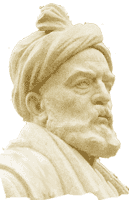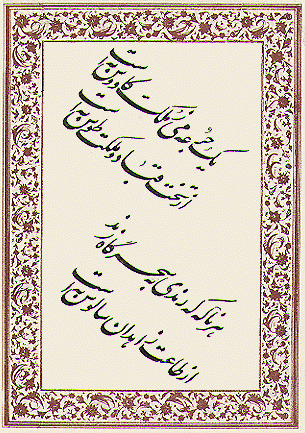The Persian language belongs to the Aryan subgroup (divided into Iranian, indo-aryan and Kafir or Nuristani languages) of the Indoeuropean languages, which include the italic languages (oscan, umbrian, venetic, etc.), Latin, Greek, Germaic, Baltic, Slavic, Celtic, Anatolian languages, Albanian and Tocharian (today extinguished). Other important iranian languages are: Kurdish, Pashto, Balochi and Ossetic.
Achaemenian Persian (558-331 B.C.)
Sasanian Persian (226-651)
After a long period of time which saw the Hellenistic empire of Alexander the Great and Seleuch, the Parthian empire of the Arsacids, and a new Persian empire, the Sassanian empire, saw the rebirth of a new Persian language named pahlavi with many resemblances to modern Persian and obviously lacking the words of Arabic origin. The Pahlavi alphabet, consonantic as those in use for the greatest part of the semitic and Muslim languages, is at the base of the elaboration of the Avestan alphabet, of Aramaic derivation and consonantic-vocalic type like that Greek and Latin. Also in the times of the Achaemenids the Aramaic language was the official language at court, just like English today in the former-colonial countries. Such writing was therefore of alphabetical type, but it made use of frequent entire Aramaic words almost as if they were ideograms, that they came therefore read in Persian based on the concept that they expressed, and not according to the sounds expressed by single letters. For example, the word nāmag meant "letter" (Modern Persian nāmeh), and it was written shmk (!!!), where shm (Hebrew shem, Arab ism) is the Aramaic for nām, two words that mean "name"!!! Among the most important inscriptions in Pahlavi we should remember those in Tāq-e Bostān a Kermānshāh and that on Ka‘beh-ye Zartosht in Naqsh-e Rostam, near Shīrāz.
Islamic, or Classic, or Modern Persian (651-today)
Persian international language
Muslim Persian spread over an immense surface, and thanks to its prestige it succeeded in prevailing upon the languages of several people who formed the empire. Some in addition to their own, others quite in substitution of it (the Hazara of the Afghanistan, as an example, descendants from the troops of Gengiz Khan, have abandoned the Mongolian language and are today monolinguals of mother Persian language). Thanks to its role of culture language, Persian has been for approximately three centuries the official language of India, before being overthrown by English in 1837. Persian has been cultivated also in the countries of Turkish language and even in Europe, in the former Ottoman empire: an important example of the passage of the Persian culture in the Balkans is given from the understood one them of Albania, founded by the Turks in 1614 and called Tirana (Tiranë) in honor of Tehran, in order to celebrate a victory in Persia. In Bosnia numerous are the Persian words entered through Turkish in the local language, among which hefta = week (from the Persian hafteh), namaz = prayer (from the Persian? namāz) and češma = fountain (from the Persian cheshmeh). Always in Bosnia, the cultural muslim Institute Ibn Sina (Avicenna, philosopher and Persian doctor) in Sarajevo offers also some lectures on the personality of Imam Khomeini and Ayatollah Khamenei: www.ibn-sina.net; and this in the centre of old Europe! Today Persian has official status and is language of current use in the following states: Iran, Afghanistan and Tajikistan; it's always Persian, but for political reasons they are called fārsī, darī and tājīk. These are the official denominations, but for example in Kabul the Afghanis say they speak fārsī (that is Persian). It is spoken also in Uzbekistan, in the surroundings of Bukhara and Samarkand. "Fārs" derives from Arabic and means "Persian". In Persian it was called "pārsī" (a word which is still in use in zoroastrian and nationalistic environments), but the Arabic word in the end has prevailed in this indo-european language. The passage p > f is typical of the Arabic language, since it doesn't have the labiale surda (when you hear an Arab speaking English, he will hardly succeed to say "peace" rather than "beace"). Some examples of the indoeuropean character of Persian: ﺭﺪﭘ pedar = padre/father; ﺭﺩﺎﻣ mādar = madre/mother; ﺮﺘﺧﺩ dokhtar = daughter, ﺭﺩﺍﺮﺑ barādar = brother; ﻥﺍﺪﻧﺩ dandān = tooth, ﻭﺮﺑﺍ abrū = brow, ﺐﻟ lab = lip, ﺎﭘ pā = foot, ﻭﺎﮔ gāv = cow; ﻡﺮﮔ garm = warm, māh = mese/month, ﻡﺍ am = am, ﺖﺳﺍ/ﻩ ast/eh = (st)/is; ﻭﺩ d? = two; ﺶﺷ shash = sei/six? noh = nove/nine, dah = dieci/ten, ﻡﺎﻧ nām = name, ﻪﻧ na = not. The written Persian language is same for the Iran and the Afghanistan (in Tagikistan it still uses the cyrillic characters introduced by Stalin, also if there isn't any lack of proposal to reintroduce the Arabo-Persian characters), while at the spoken level we can find some differences also, but not such to make us talk about different languages. Persian spoken in Kabul (darī) keeps more archaic elements than Persian of Tehran (fārsī), among which the conservation of the vocal // and//, of the diphthong /aw /, which has become /ō/ in fārsī and /av/ in tājīkī, and the nexus /khw/. Examples: Iran is written ﻥﺍﺮﻳﺍ and it is pronounced Īrān in fārsī e Ērān in Darī, fruit is written ﻩﻮﻴﻣ and is pronounced mīve in fārsī, mēwa in darī, day (ﺯﻭﺭ) is rūz in fārsī, rōz in Darī; ﻮﻧ (new) is pronounced naw in darī (nav in Tajik), but nō in Fārsī, ﺪﻨﮔﻮﺳ (oath) is pronounced sawgand in Darī (savgand in Tajik), but sōgand in fārsī; sister is khār in Fārsī, khwār in Darī (nella lingua scritta č ﺮﻫﺍﻮﺧ khwāhar < *swāsar); shīr (ﺮﻴﺷ) in fārsī means both milk and lion, while Darī makes a difference between shīr (milk) e shēr (lion). Furthermore ast (latin est) in fārsī is generally read [e], in darī is pronounced [as]. And bear in mind that all these words show no difference when written!!! Tajik is simply Darī of the Republic of Tajikistan (in fact speakers of Darī from Afghanistan are called Tajiks).
Links
Under construcion
Please take a look at the Italian section.Get in touch!
Write me.© Massimiliano Distaso 2002


